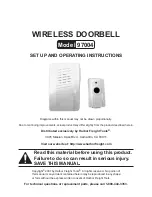
16
.
July 2014
.
IMO_347_EN_v0
Roto NT
Subject to change.
Security
Fabrication advice for timber and PVC
Maximum sash sizes and weights
The technical data, application diagrams, and component classifications in
the product-specific documentation of the hardware manufacturer give
instructions on the maximum permitted sash sizes and weights. Here, the
component with the smallest permitted load bearing capacity decides the
maximum permitted sash weight.
–
Check compliance of the technical data, application diagrams, and
component classifications before the use of electronic data sets, and
especially their use in fenestration programmes.
–
The maximum permitted sash sizes and weights must never be exceeded.
In the case of uncertainty contact the hardware manufacturer.
Guidelines from the profile manufacturer
The manufacturer of windows and/or balcony doors must comply with all
specified system-related dimensions (e.g. gasket gap dimensions or locking-
point distances). Furthermore, he must check these regularly and make
certain of them, especially on the first use of new hardware components,
during manufacture, in an ongoing manner up to and including the window
installation.
NOTE!
The hardware components should in principle be designed in such
a manner, that the system-related dimensions can be adjusted to
the extent that they are affected by the hardware. If a deviation
from these dimensions is noticed only after the installation of the
windows, the hardware manufacturer is not responsible for any
possible additional work arising.
Composition of hardware
Burglary inhibiting windows and balcony doors require hardware which
fulfils particular requirements.
Windows and balcony doors for damp rooms, and those for use in environ-
ments with aggressive and corrosive air components require hardware
which fulfils particular requirements.
The resistance of windows and balcony doors to wind loads when closed
and locked depends on the actual designs of the windows and balcony
doors. Wind loads prescribed by law and standards (e.g. as per EN
12210 –
especially test pressure P3) can be dissipated by the hardware system.
In general, the Turn-Only and Tilt&Turn hardware defined in this document
is able to fulfil legal and standard requirements for barrier-free habitations.
The hardware combinations and installations appropriate for windows and
balcony doors in the previously mentioned areas should be specifically
selected and agreed with the hardware manufacturer and the profile manu-
facturer.
NOTE!
The guidelines of the hardware manufacturer relating to the
combination of the hardware (e.g. the use of additional stay arms,
the design of hardware for burglary-inhibiting sashes for windows
and balcony doors, etc.) are binding.
Содержание NT Designo
Страница 19: ...Subject to change Roto NT IMO_347_EN_v0 July 2014 19 ...
Страница 30: ...30 July 2014 IMO_347_EN_v0 Roto NT Subject to change ...
Страница 79: ...Subject to change Roto NT IMO_347_EN_v0 July 2014 79 ...
Страница 91: ...Subject to change Roto NT IMO_347_EN_v0 July 2014 91 ...
Страница 93: ...Subject to change Roto NT IMO_347_EN_v0 July 2014 93 Maintenance Lubrication points Grease Oil ...
Страница 100: ...100 July 2014 IMO_347_EN_v0 Roto NT Subject to change ...
Страница 102: ......
Страница 103: ......
















































